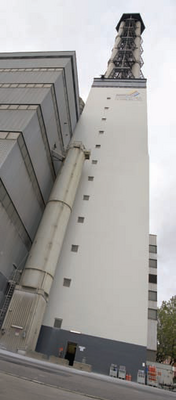The tower of the Duisburger Stadtwerke has been a landmark of this German city since 1967. It is actually the 200 metre tall chimney of the municipal power plant which generates electricity and district heating. The chimney consists of three flue gas conduits with a central lift shaft in the middle. The lift operates at a speed of 3 metres per second, carrying visitors up to an observation platform at 180 metres. The lift also takes Stadtwerke employees to five additional maintenance platforms and the adjoining main building. To reach the lift’s machinery room they need to proceed through a steep spiral staircase from the observation platform.
Since the lift is the only way of reaching the platform, an evacuation lift is provided to release people from the lift car and return them to ground level. This is a complicated and expensive measure, which makes it very important for the main lift to function reliably. This was one of the reasons for modernizing the installation and bringing the lift up to the latest technical standard.
Another reason was the difficulty involved in finding replacement parts for the old controller dating from the 1980s. The municipal services department consequently decided to fit a new DC converter while retaining the lift, the winch and the gearless DC motor.
The project was complicated by the fact that the motor is located in the machinery room at the top of the tower but the DC converter is in the basement at the foot of the lift shaft. This requires a motor and encoder cable measuring no less than 220 metres. However, the operators can conveniently carry out troubleshooting, maintenance and repairs despite the machinery room being difficult to access. Not placing the converter in the machinery room also avoids exposing the electronics to the wind and weather. When modernizing the lift installation, the lack of space in the small machinery room also made it hard to fit in an additional switchgear cabinet.
While these difficult circumstances kept a number of competitors from even considering the project, Otis Elevator Company took on the challenge. Otis is one of the world’s leading lift manufacturers, with 2.1 million installations in more than 200 countries. They hired Emotron to plan and commission the new equipment for this particular project with their product range for lift control that includes frequency inverters of up to 132kW and digital DC drives of up to 90kW. The choice for the Duisburg Stadtwerke was an Emotron GSV 5445, a fully digital DC drive developed for modernizing high-speed lifts while retaining the original motor. It has a compact design and offers very accurate speed and position control using the latest IGBT technology. The motor windings are protected against a rapid increase in voltage, which makes the drive suitable for refurbishment. All common encoder types can be used.
The most difficult challenge proved to be bringing the 1 volt rotary encoder signals point-to-point to the bottom without losses. To handle this, Emotron chose a solution from Wachendorff Automation, known for their resilient and robust encoders that are ideal for safety relevant applications. The Wachendorff standard models had been successfully used in installations with cable lengths of up to 150 metres, although in this case a special design was required.
An optimized sine wave encoder with 2048 increments was designed, in order to ensure a precise determination of the speed of the car in the lift shaft. The experts from Wachendorff, working closely with Emotron’s R&D department, also managed to transport the signal reliably over the 220 metre distance, even under considerable disturbing influences. The rotary encoder operates at a supply voltage of 15 volts, instead of the customary 5 volts, and is terminated with special resistors.

















